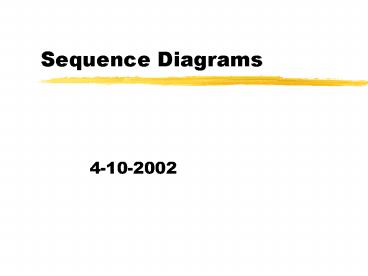Sequence Diagrams - PowerPoint PPT Presentation
Title:
Sequence Diagrams
Description:
... the design of the project, I am also implementing a client/server pair ... I'm not very far yet, but I will continue with it and on Friday at 2:30pm I will ... – PowerPoint PPT presentation
Number of Views:26
Avg rating:3.0/5.0
Title: Sequence Diagrams
1
Sequence Diagrams
- 4-10-2002
2
Opening Discussion
- You will be presenting on the 24th. That gives
you 2 more weeks to try to get a prototype
implementation. The real key for the
implementation is that it is going to tell you
where your design needs work. - Your presentation is going to focus primarily on
your design, but the more implementation you
have, the better.
3
Back to UML
- Today we are going to get back to talking about
UML diagrams. We have discussed the Use Case
diagrams for helping up with the analysis to
figure out what users will be using various parts
of our system and for what. We have also
discussed class diagrams which show us the
general layout of an object oriented design and
help us see how pieces of code fit together.
4
Sequence Diagrams
- Today we are going to look briefly at Sequence
Diagrams These diagrams are used for individual
methods to show us the passing of messages in a
method. - In particular they show us the timing of how the
different messages are passed (or methods are
called if you prefer the terminology).
5
Layout of a Sequence Diagram
- The basic layout of a sequence diagram has the
objects that receive messages listed along the
top. Often the objects are denoted by just a
class name. - The vertical axis has time advancing as you go
down so the beginning of the method is at the top
and the end is at the bottom. There is a time
line down from each object as well.
6
Calling of Methods
- When a message is passed to an object (a method
invoked), we draw an arrow from the current
method to a method on the line of that object.
The arrow is labeled with the method name. - Boxes along the line represent the method
execution. They are typically given a size that
corresponds to how long their execution should
take. Returns are implicit.
7
Asynchronous Messages
- If you have code that spawns threads so that
messages can be processed in parallel you can
denote that in a Sequence diagram with a half
arrow. - TogetherSoft has quite a few different options
for the types of messages being passed. It will
also generate Sequence diagrams from code.
TogetherSoft shows an actor to initiate the call
as well.
8
Look at Snipes Code
- To help show the flexibility of the design of the
project, I am also implementing a client/server
pair for the game Snipes. Snipes used to ship
with all Novell LANs. In some ways it was the
first 3rd person, multi-player shooter. - Im not very far yet, but I will continue with it
and on Friday at 230pm I will work on it as part
of a series on Java I have been doing.
9
Meet in Groups
- As time allows Id like you to break apart into
your groups and discuss your projects. You
should be turning in UML diagrams and group
evaluations for them to me today. Your final
presentations are in 2 weeks.































